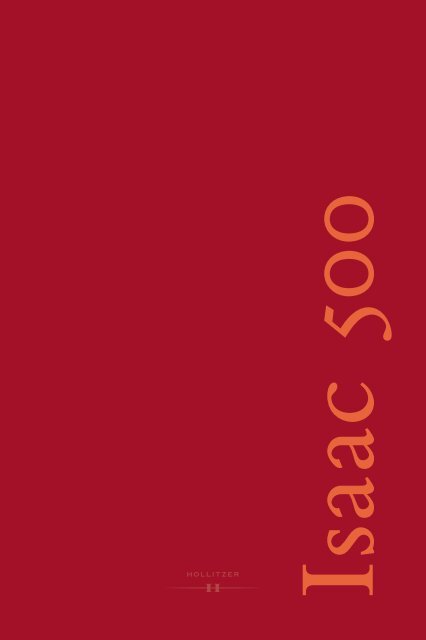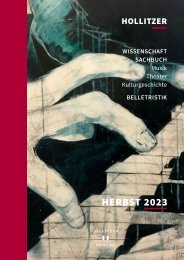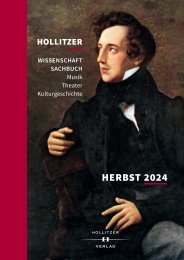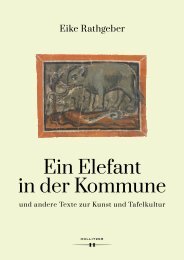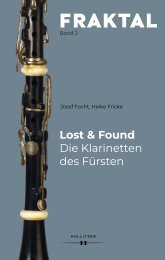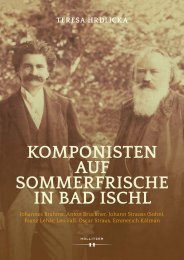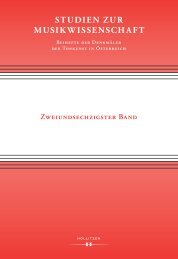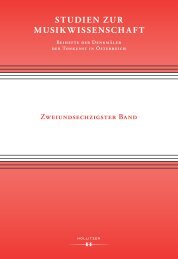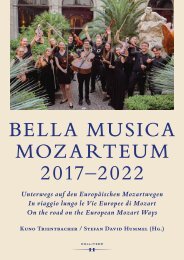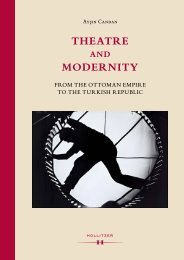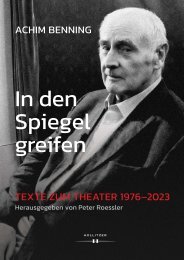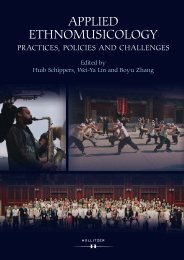Leseprobe_Henricus Isaac
Create successful ePaper yourself
Turn your PDF publications into a flip-book with our unique Google optimized e-Paper software.
<strong>Isaac</strong> 500
<strong>Henricus</strong> <strong>Isaac</strong> (c.1450/5–1517)<br />
Composition – Reception – Interpretation
WIENER FORUM<br />
FÜR ÄLTERE MUSIKGESCHICHTE<br />
Herausgegeben von Birgit Lodes<br />
BAND 11<br />
Stefan Gasch, Markus Grassl, August Valentin Rabe (Hg.)<br />
<strong>Henricus</strong> <strong>Isaac</strong> (c.1450/5–1517)<br />
Composition – Reception – Interpretation
HENRICUS ISAAC<br />
(c.1450/5–1517)<br />
COMPOSITION<br />
RECEPTION<br />
INTERPRETATION<br />
HERAUSGEGEBEN VON<br />
STEFAN GASCH, MARKUS GRASSL<br />
UND AUGUST VALENTIN RABE
Gedruckt mit Unterstützung des<br />
Instituts für Musikwissenschaft und des<br />
Dekanats der Philologisch-Kulturwissenschaftlichen Fakultät<br />
der Universität Wien<br />
sowie der Universität für Musik und darstellenden Kunst Wien.<br />
Wissenschaftlicher Beirat<br />
Anna Maria Busse Berger (USA)<br />
Paweł Gancarczyk (PL)<br />
Andreas Haug (D)<br />
Klaus Pietschmann (D)<br />
Nicole Schwindt (D)<br />
Reinhard Strohm (GB)<br />
Diese Publikation wurde im Peer-Review-Verfahren evaluiert.<br />
Umschlaggestaltung und Satz: Gabriel Fischer<br />
Hergestellt in der EU<br />
Alle Rechte vorbehalten, insbesondere die des Nachdrucks und der Übersetzung.<br />
Ohne schriftliche Genehmigung des Verlages ist es auch nicht gestattet, dieses<br />
urheberrechtlich geschützte Werk oder Teile daraus in einem photomechanischen oder<br />
sonstigen Reproduktionsverfahren zu vervielfältigen und zu verbreiten.<br />
Die Autorinnen und Autoren haben sich nach Kräften bemüht, alle Publikationsrechte<br />
einzuholen. Sollten dennoch Urheberrechte verletzt worden sein, werden die betroffenen<br />
Personen oder Institutionen gebeten, sich mit den HerausgeberInnen in Verbindung zu setzen.<br />
© Hollitzer Verlag, Wien 2019<br />
ISBN 978-3-99012-576-2<br />
ISSN 2617-2534<br />
www.hollitzer.at
Inhalt<br />
Vorwort<br />
Foreword<br />
VII<br />
XI<br />
Nicole Schwindt / Giovanni Zanovello<br />
<strong>Isaac</strong>, Schubinger, and Maximilian in Pisa – A Window of Opportunity? 1<br />
Grantley McDonald<br />
The Chapel of Maximilian I:<br />
Patronage and Mobility in a European Context 9<br />
Jessie Ann Owens<br />
Revisiting <strong>Isaac</strong>’s Autographs 25<br />
David J. Burn / Ruth I. DeFord<br />
A Recently Discovered Source for <strong>Henricus</strong> <strong>Isaac</strong>’s Mass Propers:<br />
Transmission and Scribal Initiative in Brno, City Archive, MS 14/5 65<br />
David Merlin<br />
Auf der Suche nach <strong>Isaac</strong>s Choralvorlagen:<br />
Die Missa de Beata Maria Virgine à 4 (I) und die gedruckten Liturgica 105<br />
David Fallows<br />
The two Egenolff Tenor Partbooks in Bern 123<br />
David Fallows<br />
Lucas Wagenrieder as Annotator of both Copies of the<br />
Trium vocum carmina (Nuremberg, 1538) and other Music Books 137<br />
Blake Wilson<br />
Remembering <strong>Isaac</strong> Remembering Lorenzo:<br />
The Musical Legacy of Quis dabit 153<br />
Eleanor Hedger<br />
Heinrich <strong>Isaac</strong>’s Missa Comme femme desconfortée:<br />
A Musical Offering to the Virgin Mary 177
Klaus Pietschmann<br />
Emperor Maximilian I, Audible Ideology and Heinrich <strong>Isaac</strong>’s<br />
Optime pastor 189<br />
Markus Grassl<br />
‘Et comenchèrent les sacqueboutes du roy’:<br />
The Liturgical Use of Instrumental Ensembles Around 1500 209<br />
Franz Körndle<br />
Anmerkungen zu Orgel, Alternatim und Ablass um 1500 247<br />
August Valentin Rabe<br />
‘Singing into the Organ’: On the Use of the Organ in Alternatim<br />
Performance in <strong>Henricus</strong> <strong>Isaac</strong>’s Time 267<br />
Kateryna Schöning<br />
<strong>Isaac</strong> in Lautenintavolierungen aus handschriftlichen und gedruckten<br />
Quellen (ca. 1500–1562): ein Beitrag zur Intavolierungstechnik 305<br />
Ivo Ignaz Berg<br />
Performative Dimensionen der Mensuralnotation:<br />
<strong>Isaac</strong>s Missa de Beata Maria Virgine aus dem Chorbuch gesungen 325<br />
Tagungsprogramm / Conference programme 347<br />
Anmerkungen zum Tagungskonzert 351<br />
Autorinnen und Autoren 353<br />
Abstracts 357<br />
Verzeichnis der verwendeten Abkürzungen 365<br />
Personen- und Werkregister 369
VORWORT<br />
„Mir scheint [<strong>Isaac</strong>] gut geeignet Eurer Hoheit zu dienen, mehr als Josquin,<br />
denn er ist umgänglicher und wird häufiger neue Stücke schreiben.“ So lautet<br />
das oft zitierte Urteil von Gian de Artiganova, der 1502 im Auftrag von<br />
Ercole d’Este nach einem neuen Maestro di Capella für den Hof in Mantua<br />
Ausschau hielt. Der Herzog aber folgte bekanntlich dem Rat seines anderen<br />
Agenten Girolamo da Sestola, der ihm Josquin Desprez als „corona a la dita<br />
nostra chapela“ empfohlen hatte. Man könnte meinen, diese Einschätzung habe<br />
bis ins 20. Jahrhundert überlebt, denn obwohl die musikhistorische Bedeutung<br />
<strong>Henricus</strong> <strong>Isaac</strong>s von Beginn der neueren Musikgeschichtsschreibung an unbestritten<br />
war, stand er lange Zeit nicht in jenem Maß im Fokus der Forschung<br />
– und der musikalischen Praxis – wie andere franko-flämische Sänger-Komponisten<br />
des 15. und 16. Jahrhunderts, allen voran sein Zeitgenosse Josquin<br />
Desprez. Erst seit rund 20 Jahren beginnt sich die Forschung <strong>Henricus</strong> <strong>Isaac</strong><br />
wieder intensiver anzunehmen. Mittlerweile sind Arbeiten zu einem breiten<br />
thematischen Spektrum vorgelegt worden, das von der Biographie und dem<br />
historischen bzw. kulturellen Umfeld über Quellen- und Überlieferungsfragen,<br />
Aspekte der Kompositionstechnik und des Schaffensprozesses bis hin zur<br />
Rezeption reicht.<br />
Das 500. Todesjahr <strong>Henricus</strong> <strong>Isaac</strong>s 2017 war Anlass, in zwei Veranstaltungen,<br />
die von den Herausgebern dieses Bands gemeinsam mit Birgit Lodes organisiert<br />
wurden, einen weiteren Impuls für die vertiefte Auseinandersetzung<br />
mit <strong>Isaac</strong> zu geben: In Wien fand die internationale Tagung <strong>Henricus</strong> <strong>Isaac</strong>:<br />
Composition – Reception – Interpretation statt, die wenige Tage später in Prag von<br />
der Panel Session Commemorating <strong>Henricus</strong> <strong>Isaac</strong> im Rahmen der 45. Medieval and<br />
Renaissance Music Conference weitergeführt wurde. Der Großteil der in diesem<br />
Band versammelten Beiträge geht auf Vorträge zurück, die bei diesen Veranstaltungen<br />
gehalten wurden.<br />
Am Anfang stehen zwei Texte zur Biographie <strong>Isaac</strong>s bzw. zu den institutionellen<br />
Rahmenbedingungen seines Wirkens. Nicole Schwindt und Giovanni<br />
Zavonello machen plausibel, dass Augustein Schubinger eine Schlüsselrolle<br />
bei der Anwerbung <strong>Isaac</strong>s durch Maximilian I. gespielt haben könnte, Grantley<br />
McDonald macht den engen Zusammenhang deutlich, der an der Kapelle<br />
VII
Vorwort<br />
Maximilians zwischen deren internationalem Charakter, der Beziehung zu<br />
anderen Institutionen, der Wahrnehmung administrativer Aufgabe durch<br />
Kapellangehörige und dem System der Benefizienvergabe bestand. Darauf folgen<br />
mehrere Beiträge, die einzelne Quellen oder Quellenkorpora mit Musik<br />
<strong>Isaac</strong>s unter je verschiedener Perspektive in den Blick nehmen. Jessie Ann<br />
Owens kommt noch einmal auf das Autograph von <strong>Isaac</strong>s Sequenz Sanctissime<br />
virginis votiva festa zurück und aktualisiert im Lichte jüngster Forschungen die<br />
Erkenntnisse zur Authentizität der Aufzeichnung und die Einsichten, welche<br />
die Quelle in den Kompositionsprozess erlaubt. Das vor Kurzem entdeckte<br />
Brünner Chorbuch CZ-Bam 14/5, das zahlreiche Propriumsvertonungen<br />
<strong>Isaac</strong>s enthält, ist Gegenstand des Aufsatzes von David J. Burn und Ruth I.<br />
DeFord, die das Verhältnis dieser Quelle zum Choralis Constantinus bestimmen<br />
und deren Bedeutung für die Erhellung der Rezeption von <strong>Isaac</strong>s Musik im<br />
weiteren 16. Jahrhundert herausstreichen. Eine Reihe von gedruckten Gradualia<br />
aus der Zeit um 1500 werden von David Merlin herangezogen, um durch<br />
einen exemplarischen Vergleich der in diesen Ausgaben überlieferten Choralfassungen<br />
mit den cantus firmi der Missa de Beata Maria Virgine 4vv (I), zur<br />
Klärung des komplexen Problems von <strong>Isaac</strong>s Choralvorlagen beizutragen.<br />
David Fallows diskutiert Autorenzuschreibungen in den beiden neu entdeckten<br />
Stimmbüchern Christian Egenolffs und bietet in einem weiteren Text eine<br />
Zusammenschau der Annotationen von <strong>Isaac</strong>s Kapellkollegen Lucas Wagenrieder<br />
in den beiden erhaltenen Exemplaren von Formschneiders Trium vocum<br />
carmina.<br />
Mit einzelnen Kompositionen <strong>Isaac</strong>s beschäftigen sich die drei folgenden<br />
Studien. Blake Wilson geht den Spuren nach, die Quis dabit capiti meo aquam<br />
in Madrigalen von Costanzo Festa, Francesco Layolle und Philippe Verdelot<br />
hinterlassen hat, Eleanor Hedger rückt die Missa Comme femme desconfortée in<br />
den Kontext der Marienverehrung und Klaus Pietschmann entwickelt die<br />
These, wonach die Motette Optime pastor anlässlich des Empfangs des päpstlichen<br />
Nuntius am kaiserlichen Hof 1514 entstand.<br />
Ein Tag des Wiener Symposiums war dem Korpus von alternatim zu realisierenden<br />
Choralmessen gewidmet. Dieser für <strong>Isaac</strong> typische, durch die Forschung<br />
jedoch nur wenig bearbeitete Werkbestand sollte dabei nicht zuletzt<br />
unter aufführungspraktischen Gesichtspunkten behandelt werden. Den Referaten<br />
ging eine Aufführung der Missa de Beata Maria Virgine, 4vv (I), durch<br />
das Ensemble Nusmido voran. Mit dieser exemplarischen Erarbeitung einer der<br />
Choralmessen <strong>Isaac</strong>s sollte zugleich ein Ausgangspunkt für eine diesen Teil<br />
des Symposiums abschließende, Wissenschaft und Aufführungspraxis in Austausch<br />
bringende Roundtable-Diskussion geliefert werden (siehe das Tagungsprogramm<br />
und die Anmerkungen zum Tagungskonzert am Ende des Buches).<br />
VIII
Vorwort<br />
Drei der Beiträge, die im Rahmen dieses Programmteils präsentiert wurden,<br />
behandeln Aspekte der alternatim-Praxis um 1500 und damit Voraussetzungen<br />
und Kontext von <strong>Isaac</strong>s Choralmessen. Vor dem Hintergrund der verstärkten,<br />
gerade auch am Hof Maximilians I. betriebenen Einbindung von Blasinstrumenten<br />
in die liturgische Musikpflege zeigt Markus Grassl, dass und auf<br />
welche Weise auch Bläserensembles an der alternatim-Praxis beteiligt waren.<br />
Franz Körndle beleuchtet Orgeln und Orgelbau im Umfeld Maximilians I.<br />
und kann aus dem instrumentenhistorischen Befund Rückschlüsse auf die Verwendung<br />
von Orgeln in der Liturgie bzw. in der Kapelle Maximilians ziehen.<br />
Anhand verschiedener theoretischer wie praktischer Quellen zielt August<br />
Rabe auf die Rekonstruktion der konkreten musikalischen Gestalt des alternatim-Spiels<br />
auf der Orgel sowie der damit verbundenen ästhetischen Vorstellungen.<br />
Ebenfalls der instrumentalmusikalischen Praxis widmet sich der Beitrag<br />
von Kateryna Schöning, der den Umgang mit Kompositionen <strong>Isaac</strong>s in Lautentabulaturen<br />
untersucht und damit ein weiteres Schlaglicht auf die Rezeption<br />
von <strong>Isaac</strong>s Musik im 16. Jahrhundert wirft. Ausgehend von den Erfahrungen<br />
bei der Einstudierung und Aufführung von <strong>Isaac</strong>s Missa de Beata Maria<br />
Virgine mit dem Ensemble Nusmido erörtert schließlich dessen Leiter, Ivo Ignaz<br />
Berg, welche praktische Konsequenzen und performative Implikationen das<br />
Singen aus dem Chorbuch und der Mensuralnotation mit sich bringt.<br />
Unser herzlicher Dank gilt Birgit Lodes für die Aufnahme des Bandes in<br />
die Reihe Wiener Forum für ältere Musikgeschichte; der Universität Wien und der<br />
Universität für Musik und darstellende Kunst Wien, die mit ihrer finanziellen<br />
Unterstützung das Symposium und die vorliegende Veröffentlichung überhaupt<br />
erst möglich gemacht haben; und schließlich Michael Hüttler und Sigrun<br />
Müller (Hollitzer Wissenschaftsverlag) für die stets angenehme und geduldige<br />
Zusammenarbeit bei der Herstellung des Buchs.<br />
Die Herausgeber Wien, im August 2019<br />
IX
FOREWORD<br />
‘To me, [<strong>Isaac</strong>] seems well suited to serve Your Lordship, more so than Josquin,<br />
because he is more companionable, and will compose new works more often.’<br />
This is the oft-quoted verdict of Gian de Artiganova, who Ercole d’Este commissioned<br />
in 1502 to look for a new Maestro di Capella for the court in Mantua.<br />
As is well known, however, the Duke followed the advice of his other agent,<br />
Girolamo da Sestola, who had recommended Josquin Desprez as the ‘crown<br />
upon this chapel of ours’. It seems that this assessment survived into the 20th<br />
century, for although <strong>Henricus</strong> <strong>Isaac</strong>’s music-historical significance was undisputed<br />
from the beginning of the newer historiography of music, for a long<br />
time he remained less the focus of research – and musical practice – than other<br />
Franco-Flemish singer-composers of the fifteenth and sixteenth centuries,<br />
above all his contemporary Josquin Desprez. It is only in the last 20 years that<br />
musicology has begun to take a more serious interest in <strong>Henricus</strong> <strong>Isaac</strong> again.<br />
In that time, a broad thematic spectrum of work has been produced, ranging<br />
from biography and the historical and cultural environment to questions of<br />
sources and tradition, aspects of compositional technique and the creative process,<br />
and reception.<br />
The 500th anniversary of <strong>Henricus</strong> <strong>Isaac</strong>’s death in 2017 gave further impetus<br />
to the desire to examine <strong>Isaac</strong> in more depth, which culminated in two<br />
events organised by the editors of this volume together with Birgit Lodes: the<br />
international conference <strong>Henricus</strong> <strong>Isaac</strong>: Composition – Reception – Interpretation<br />
in Vienna, followed a few days later by the panel session ‘Commemorating<br />
<strong>Henricus</strong> <strong>Isaac</strong>’ at the 45th Medieval and Renaissance Music Conference in Prague.<br />
Most of the contributions in this volume are based on talks given at these<br />
events.<br />
The first two texts explore <strong>Isaac</strong>’s biography and the institutional framework<br />
of his work. Nicole Schwindt and Giovanni Zavonello suggest that<br />
Augustein Schubinger might have played a key role in Maximilian I’s recruitment<br />
of <strong>Isaac</strong>; Grantley McDonald makes clear the close connection that<br />
existed between the international character of Maximilian’s chapel, its relationship<br />
to other institutions, the administrative duties of its members and the<br />
system of benefit allocation. These are followed by several contributions that<br />
XI
Foreword<br />
bring different perspectives to bear on individual sources or source corpuses<br />
of <strong>Isaac</strong>’s music. Jessie Ann Owens returns to the autograph of <strong>Isaac</strong>’s sequence<br />
Sanctissime virginis votiva festa and, in the light of recent research, updates the<br />
findings on the record’s authenticity and the insights the source offers into<br />
<strong>Isaac</strong>’s composition process. The recently discovered choirbook in Brno,<br />
CZ-Bam 14/5, which contains numerous Mass Proper settings by <strong>Isaac</strong>, is the<br />
subject of an essay by David J. Burn and Ruth I. DeFord, who determine this<br />
source’s relationship to the Choralis Constantinus and emphasise its significance<br />
for illuminating the reception of <strong>Isaac</strong>’s music later in the sixteenth century.<br />
David Merlin uses several printed gradualia from the period around 1500 to<br />
help clarify the complex problem of <strong>Isaac</strong>’s chorale models by comparing the<br />
chorale versions handed down in these editions with the cantus firmi of the<br />
Missa de Beata Maria Virgine 4vv (i). David Fallows discusses author attributions<br />
on the basis of the two prints by Christian Egenolff and, in a further text,<br />
offers a synopsis of the annotations by <strong>Isaac</strong>’s fellow musician Lucas Wagenrieder<br />
in the two surviving copies of Hieronymus Formschneider’s Trium vocum<br />
carmina.<br />
The following three studies deal with individual <strong>Isaac</strong> compositions. Blake<br />
Wilson follows the traces left by Quis dabit capiti meo aquam in madrigals by<br />
Costanzo Festa, Francesco Layolle, and Philippe Verdelot; Eleanor Hedger<br />
places the Missa Comme femme desconfortée in the context of Marian worship;<br />
and Klaus Pietschmann develops the thesis that the motet Optime pastor was<br />
written for the reception of the papal nuncio at the imperial court in 1514.<br />
One day of the Vienna Symposium was dedicated to the corpus of choral<br />
masses that are realised alternatim. This group of works, typical for <strong>Isaac</strong>, but<br />
little researched, was treated mainly from the point of view of performance<br />
practice. The papers were preceded by a performance of the Missa de Beata<br />
Maria Virgine 4vv (i), by the Ensemble Nusmido. This exemplary realisation of<br />
one of <strong>Isaac</strong>’s choral masses was also intended to provide a starting point for a<br />
roundtable discussion that concluded this part of the symposium and brought<br />
theory and performance practice into profitable exchange (see the conference<br />
programme and the notes on the conference concert at the end of the book).<br />
Three of the contributions presented in this part of the programme dealt with<br />
aspects of alternatim practice around 1500 and thus the conditions and context of<br />
<strong>Isaac</strong>’s plainchant masses. Against the background of the increased integration<br />
of wind instruments into liturgical music, especially at the court of Maximilian<br />
I, Markus Grassl shows that wind ensembles were also involved in alternatim<br />
practice and describes how. Franz Körndle examines organs and organ<br />
building in the time of Maximilian I and draws conclusions from these historical<br />
findings about how organs were used in the liturgy and at Maximilian’s<br />
XII
Foreword<br />
chapel. Based on various theoretical and practical sources, August Rabe reconstructs<br />
the concrete musical form of alternatim playing on the organ and the<br />
associated aesthetic ideas.<br />
Kateryna Schöning’s contribution is also devoted to instrumental musical<br />
practice. She investigates how <strong>Isaac</strong>’s compositions are handled in lute tablatures<br />
and thus sheds further light on the reception of <strong>Isaac</strong>’s music in the sixteenth<br />
century. Finally, based on the experience of rehearsing and performing<br />
<strong>Isaac</strong>’s Missa de Beata Maria Virgine with the Ensemble Nusmido, its director,<br />
Ivo Ignaz Berg, discusses the practical consequences and performative implications<br />
of singing from the choir book and its mensural notation.<br />
Our heartfelt thanks go to Birgit Lodes for including the volume in the<br />
series Wiener Forum für ältere Musikgeschichte; to the University of Vienna<br />
and the University of Music and Performing Arts Vienna, whose financial support<br />
made the symposium and this publication possible in the first place; and<br />
finally to Michael Hüttler and Sigrun Müller (Hollitzer Wissenschaftsverlag)<br />
for their ever warm and patient support during the production of the book.<br />
The Editors<br />
August 2019, Vienna.<br />
XIII
Nicole Schwindt / Giovanni Zanovello*<br />
ISAAC, SCHUBINGER, AND MAXIMILIAN<br />
IN PISA – A WINDOW OF OPPORTUNITY?<br />
As is well known, Heinrich <strong>Isaac</strong> was hired by Maximilian in Pisa in the autumn<br />
of 1496. The significance of this supreme acquisition was always clear,<br />
both for musicologists and historians of the Habsburg court. At times it even<br />
appears as the cornerstone of the foundation of the Vienna court chapel, since<br />
<strong>Isaac</strong> and his wife were directly sent to this city, where the King of the Romans<br />
had the members of his reorganized chapel gather. Yet it would be more difficult<br />
to argue that the ruler wished to have a composer of international reputation<br />
among his musicians, let alone that he was actively seeking such a personality<br />
at the time. 1496 was the first of three years marked by severe financial<br />
problems for the king. The campaign of Italy turned out to be so expensive that<br />
even the food for the court members at home was not always guaranteed. The<br />
campaign itself (July 5–November 18, 1496) suffered from insufficient financial<br />
resources from the beginning and ended in disaster. 1 It may seem strange that at<br />
the end of this depressing period Maximilian addressed the task of reorganizing<br />
his chapel, by then noticeably downsized and transferred from Augsburg to<br />
Vienna. Even stranger that right at this time, when he was ‘completely broke’<br />
(ganz ploss) to the point that he could not provide for his wife, 2 he entered into<br />
negotiations with a Florence-based Flemish musician to join his musical institution.<br />
On November 13 in Pisa his chief secretary, Zyprian von Serntein, gave<br />
* The idea for this joint article was born during the <strong>Isaac</strong> conference in Zürich in March<br />
2017, when Nicole Schwindt referred briefly to a citation of the document discussed<br />
below in Lorenz Böninger’s Die deutsche Einwanderung nach Florenz im Spätmittelalter<br />
(Leiden, 2006) and asked Giovanni Zanovello if he would be interested in further investigation.<br />
We are thankful to Daria Rose Foner (Columbia University) for access to the<br />
document, to Veronica Vestri (Florence) for her assistance with the transcription, and to<br />
Molly Covington (Indiana University) for her help editing the final text.<br />
1 Hermann Wiesflecker, Kaiser Maximilian I. Das Reich, Österreich und Europa an der Wende<br />
zur Neuzeit, ii (Vienna, 1975), 71–116.<br />
2 For reference see www.regesta-imperii.de (= RI), vol. XIV, 2 n. 4486.<br />
1
Nicole Schwindt / Giovanni Zanovello<br />
Fig. 1: Florence, Archivio di Stato, Notarile Antecosimiano 1972 (1489), fol. 147 r<br />
2
<strong>Isaac</strong>, Schubinger, and Maximilian in Pisa – A Window of Opportunity?<br />
orders on behalf of his lord for the transfer of the newly engaged ‘Ysaagkh’, his<br />
wife, and the other chapel members to Vienna. 3 To be sure, at no time did a<br />
military defeat keep Maximilian from planning his future as emperor of the<br />
Holy Roman Empire. In particular, he was hoping to be crowned by the pope<br />
in Rome and access a rank that would quite naturally oblige him to maintain<br />
a representative musical establishment. A singer and composer of international<br />
standing, acting as a beacon in an otherwise completely German chapel, would<br />
be the cherry on the cake. It is very hard to demonstrate that Maximilian had<br />
this kind of strategic foresight in musical matters, though it cannot be ruled<br />
out either. Regardless, the Fall of 1496 was hardly an appropriate moment to<br />
increase the royal staff. What happened in Pisa, where the king was residing<br />
since October 21 4 in the Medici palace? An archival document from Florence,<br />
that at first glance has nothing to do with the Pisan affair, might help explain<br />
this untimely hiring decision.<br />
***<br />
Transcription:<br />
[on the left:] Locatio<br />
Item postea et cetera eisdem anno et indictione die II decembris 1489.<br />
Actum in dicto |<br />
palatio presentibus Francisco Nicole Simonis et |<br />
ser Ioanne Baptista Pierantonii de Paganuccis testibus. 5 |<br />
Iohannes … de Tondinis olim capsonarius florentinus pro se et suis |<br />
heredibus locavit ad pensionem |<br />
Augustino Ulrighi de Almania tromboni ad presens dominationis |<br />
Florentie presenti et conducenti et cetera |<br />
Vnam domum cum sala et cameris et curia, puteo interno et aliis suis |<br />
habituris positam Florentiae in populo Sancti Laurentii de Florentia in via |<br />
Argenti 6 nuncupata cui a primo dicta via, a secundo bona Gerozii de Medicis<br />
a tertio |<br />
bona sotietatis del Bigallo a quarto dicti locatoris in predictis confinis |<br />
pro tempore undecim mensium proximorum futurorum initiatorum die primo<br />
presentis mensis infrascripti |<br />
3 RI XIV, 2 n. 4487, 4488, 4489.<br />
4 From October 29 to November 5 he was embarked for Livorno, from November 12 to 15<br />
he stayed in Vico Pisano, on November 18 he left Pisa.<br />
5 Paganucci, a public notary, was one of the witnesses to <strong>Isaac</strong>’s last testament in 1516; see<br />
Martin Staehelin, Die Messen Heinrich <strong>Isaac</strong>s, Publikationen der Schweizerischen Musikforschenden<br />
Gesellschaft II/28 (Berne, 1977), ii, 85. On <strong>Isaac</strong>’s testaments, see also Giovanni<br />
Zanovello, ‘Master Arigo Ysach, Our Brother: New Light on <strong>Isaac</strong> in Florence,<br />
1502–17’, in JM 25 (2008), 297–303.<br />
6 <strong>Isaac</strong>’s residence until 1513 was on the same street. Staehelin, Die Messen, ii, 71.<br />
3
Nicole Schwindt / Giovanni Zanovello<br />
dexembris pro pensione dicti temporis XI mensium florenorum septem<br />
largorum de grossis et |<br />
solvendorum per hos menses per totum mensem aprilis florenos quattuor<br />
similes residuos videlicet florenos 3 1/3 per totum mensem octobris |<br />
mensibus infrascriptis; |<br />
promictens dictus locator conductori predicto dicta bona alteri non locare<br />
et cetera et e |<br />
converso dictus conductor et visis presentibus et mandatis. |<br />
Cornelius Laurentii de Alamania et cantores et ipsius quilibet se |<br />
Arrigus Ugonis de Alamania<br />
principaliter et in solidum et cetera<br />
obligando |<br />
promiserunt dicto locatori petere et cetera excipere et cetera quod dicta bona<br />
[…] dictus conductor |<br />
adhibere boni, loci et cetera sive temporis denuntiet et cetera et solvere<br />
pensionem et cetera ad |<br />
pretium alias predictum proprio de sermone et cetera promiserunt […]<br />
Translation:<br />
[on the left:] Rent<br />
Item afterwards etc. the same year and indiction, day 2 of December 1489.<br />
Drawn in the said |<br />
palace, in the presence of ser Francesco of Nicola of Simone and |<br />
ser Giovanni Battista of Pierantonio Paganucci as witnesses.<br />
Giovanni … Tondini, former banker, on his behalf and on behalf of his |<br />
heirs leased for a rent |<br />
to Augustin of Ulrich from Alemania, trombone player, currently present and<br />
residing in the territory |<br />
of Florence etc. |<br />
One house with hall and rooms and courtyard, an internal well, and its other |<br />
annexes, located in Florence, in the parish of San Lorenzo in via |<br />
dell’Argento delimited in the first place by the said street, then by the property<br />
of Gerozio de’ Medici, then by |<br />
the property of the society of the Bigallo, and finally by the [property of the]<br />
said landlord in the aforementioned boundary |<br />
for the time of the next eleven months, beginning on the first day of the<br />
present month of December |<br />
inscribed above for a rent of said 11 months of seven large florins and |<br />
to be paid for those months for the whole month of April four similar florins,<br />
that is 3 ½ for the whole month of October |<br />
[to be paid] for the months mentioned above |<br />
Said landlord promises not to lease the said property to others etc. and for his |<br />
part the tenant has considered the present scripture and rules. |<br />
Cornelio di Lorenzo from Alamania and<br />
singers and each pledging for<br />
himself |<br />
Arrigo d’Ugo from Alamania and offering a full guarantee |<br />
of repayment, promised to the said landlord to request etc. etc. that said tenant |<br />
4
<strong>Isaac</strong>, Schubinger, and Maximilian in Pisa – A Window of Opportunity?<br />
will use the property, the place etc. and observe the rental period etc. and will<br />
pay the rent etc |<br />
according to the amount registered elsewhere according to the contract etc.<br />
promised.<br />
***<br />
Three musicians active in the environment of Lorenzo de’ Medici are involved<br />
in this rental contract from December 1489: the instrumentalist Augustin<br />
Schubinger as tenant and the singers Cornelio di Lorenzo and Heinrich <strong>Isaac</strong><br />
as his warrantors. They all are generically referred to as ‘German’ (‘de almania’<br />
or ‘de alamania’), though Schubinger was born in (today south-German)<br />
Augsburg, Cornelio di Lorenzo in (today Belgian) Antwerp, 7 <strong>Isaac</strong> or Arrigus 8<br />
Ugonis – was Flemish, too. The background to this seemingly cumbersome<br />
covenant is the fact that the German immigrants in Florence did not have their<br />
own bank there, which would serve as an institutional guarantor for payment<br />
to the landlord, Giovanni Tondini. Instead two fideiussores had to act as<br />
guarantors. This explanation is given by the historian Lorenz Böninger, who<br />
first mentioned this contract as typical of the solidarity practiced within the<br />
German community in Florence. 9 However, it is remarkable that two singers<br />
vouched for the instrumentalist, not Schubinger’s nearest fellows, the (mostly<br />
German) members of the wind band.<br />
Augustin Schubinger, famous scion of a splendid family of German civic<br />
musicians – father Ulrich sr. and four sons Michel, Augustin, Ulrich jr.,<br />
and Anton – came to Florence in order to replace the just-deceased ‘Magister<br />
Johannes’. He was recommended by his brother Michel who belonged to<br />
the Ferrarese court pifferi and assured Lorenzo il Magnifico in a 1489 letter<br />
from Modena that his brother would be willing and able to join the Florentine<br />
7 For information on ‘Cornelio di Lorenzo d’Anversa’ in Florence (active from 1483 as<br />
soprano in the friary of Santissima Annunziata, as well from 1484 to 1490 at S. Giovanni)<br />
see Frank D’Accone, ‘The Singers of San Giovanni in Florence during the 16th Century’,<br />
in JAMS 14 (1961), 307–58.<br />
8 Each newly arrived foreigner immediately had to replace his name by a standardized<br />
name not necessarily relating to his former name. Thus there were hundreds of persons<br />
called ‘Arrigho’: L. Böninger, Die deutsche Einwanderung (see p. 1, n. *), 11.<br />
9 Ibid., 127. Independently, L. Böninger, living in Florence, pointed John Nádas to this<br />
contract, when he was preparing his article ‘Some New Documentary Evidence Regarding<br />
Heinrich <strong>Isaac</strong>’s Career in Florence’, in Firenze e la musica: Fonti, protagonisti, committenza.<br />
Scritti in ricordo di Maria Adelaide Bartoli Becherini, ed. Cecilia Bacherini, Giacomo<br />
Sciommeri and Agostino Ziino (Rome, 2014), 45–64, at 47 n. 3. Without knowing who ‘a<br />
certain Augustino Ulrighi de Alamania, trombone’ was, he could not realize the implications<br />
of this document and did not pursue the constellation.<br />
5
Nicole Schwindt / Giovanni Zanovello<br />
band as trombonist. 10 Before that appointment, Augustin was in the service of<br />
Maximilian’s father, Emperor Frederick III, where he had moved at the beginning<br />
of 1487 from his employment with the town of Augsburg. 11 Although he<br />
was an excellent lutenist as well, his core competence was as a player of shawm,<br />
trombone, and cornetto. As such, he must have been constantly in contact with<br />
<strong>Isaac</strong>, who composed music potentially suitable for the Florentine pifferi.<br />
After the death of Lorenzo il Magnifico in 1492, the subsequent decline<br />
of Florentine musical life, and the definitive dissolution of all chapels and<br />
ensembles in April 1493, Schubinger returned to his native country no later<br />
than 1493 or 1494. 12 In 1495 he is well documented as ‘des Ku Mt Trumbetter’<br />
(‘trumpeter of His Majesty the King’). 13 This time – Frederick III had died<br />
in 1493 – he had joined the Habsburg court musicians, recently reorganized.<br />
Until 1494, Maximilian had been gradually replacing the members of his<br />
Burgundian chapel 14 with German musicians – incorporating newly recruited<br />
singers and instrumentalists along with performers from the late Emperor’s<br />
chapel. From then on, Schubinger was one of Maximilian’s and his court’s<br />
dearest instrumentalists, highly esteemed as a virtuoso of the fashionable cornetto<br />
along with the trombonist Hans Steudl in the service of the chapel, and<br />
appreciated as lutenist at table and in the chamber. Augustin may have wished<br />
to return to an Italian court, or perhaps rulers such as the Mantuan Marquis<br />
were interested in engaging him: Erasmo Brascha, the Milanese ambassador<br />
10 Archivio di Stato, Firenze, MAP, XLI, 158. See Enrico Barfucci, Lorenzo de’ Medici e la<br />
società artistica del suo tempo (Florence, 1964), 101; Bianca Becherini, ‘Relazioni di musici<br />
fiamminghi con la corte dei Medici’, in Rinascita 4 (1941), 84–112: 106–8. For general<br />
information on the family see Keith Polk, ‘The Schubingers of Augsburg; Innovation in<br />
Renaissance Instrumental Music’, in Quaestiones in musica. Festschrift für Franz Krautwurst,<br />
ed. Friedhelm Brusniak (Tutzing, 1989), 495–503; id., ‘Augustein Schubinger and the<br />
Zinck: Innovation in Performance Practice’, in Historic Brass Society Journal 1 (1989), 83–92.<br />
11 Augsburg, Stadtarchiv, Baumeisterbücher, 80 (1487), fol. 65 r : ‘Augustin Schubinger<br />
busauner […] Rt. ij v ß für 3 wochen antzal der quattember vnd ist daruff abgeschiden zu<br />
vnnserm Herren dem Ro. Kaÿser vnd vff seiner Kayserlichen gnaden schreiben seins<br />
dinsts erlassen. Samstag vor Iudica [March 31]’. One year later he got a separate gratification:<br />
‘Item ij fl Augustin Kaysers Busaner Samstag vor Reminiscere [March 1]’: ibid. 81<br />
(1488), fol. 16 r .<br />
12 Schubinger last appears in the Florentine accounts in 1493: Keith Polk, ‘Civic Patronage<br />
and Instrumental Ensembles in Renaissance Florence’, in Augsburger Jahrbuch für Musikwissenschaft<br />
3 (1986), 51–68, at 68 (after Archivio di Stato, Firenze, CCCamp., fol. 305 v ).<br />
The accounts of 1494 are not complete, in the surviving parts, however, his name does not<br />
show up any longer within musicians: ibid., 59 n. 23.<br />
13 Augsburg, Stadtarchiv, Baumeisterbücher, 89 (1495), fol. 17 r , dated Saturday before<br />
‘Mathie appostoli’, i.e. February 21.<br />
14 Last payments to singers with French names were settled in 1494. See Honey Meconi,<br />
Pierre de La Rue and Musical Life at the Habsburg-Burgundian court (Oxford, 2003), 27.<br />
6
<strong>Isaac</strong>, Schubinger, and Maximilian in Pisa – A Window of Opportunity?<br />
at the Habsburg court, warmly recommended to Francesco Gonzaga the German<br />
lute player ‘virtuoso Augostino’ who, as he wrote, was much beloved by<br />
the whole court and who much delighted Maximilian. 15 However, Schubinger<br />
stayed at the Habsburg court as one of its most prominent musicians, with<br />
only an absence in 1500–6, when he was ‘lent’ by Maximilian to his son Philip<br />
the Fair in Brussels and Mechelen. In his double function as cornetto and lute<br />
player, he also undertook travels to Spain and back to Innsbruck and Augsburg<br />
with Philip’s Burgundian chapel, where he may have met again his Florentine<br />
colleague Alexander Agricola.<br />
No evidence indicates that Schubinger had accompanied Maximilian on the<br />
campaign to Italy in 1496. However, precisely because of his ‘economic’ dual<br />
function and in view of his Italian experience, it cannot be excluded that he<br />
would have been a fitting candidate for participation in a reduced music ensemble<br />
during the travel. Hence the very reasonable hypothesis that Schubinger<br />
may have arranged the encounter of Maximilian and <strong>Isaac</strong> in Pisa, about 80<br />
kilometres from Florence. Given our knowledge of habitual networks of musicians,<br />
we can assume that after his departure from Florence he had remained in<br />
contact (at least sporadically) with musicians who stayed behind in the town,<br />
including his former colleague <strong>Isaac</strong>, who was still resident there but presumably<br />
unemployed. It would have been by all means possible for Schubinger to<br />
inform <strong>Isaac</strong> about the king’s on-going musical reorganization and his travel<br />
to Italy. If Schubinger was not himself present in Pisa, one might imagine that<br />
written contacts with <strong>Isaac</strong> may have taken place beforehand. Or perhaps it<br />
was the other way around, and it was <strong>Isaac</strong> who approached Schubinger. Whoever<br />
took the initiative Schubinger would be an excellent advocate to convince<br />
Maximilian of <strong>Isaac</strong>’s outstanding quality and to make clear that hiring this<br />
singer-composer was an opportunity not to be missed. By so doing, Schubinger<br />
would have been able to kill two birds with one stone: he (re)gained a colleague<br />
who would likely continue to compose brilliant instrumental pieces, and he<br />
could repay an old debt – the support he received when <strong>Isaac</strong> had signed an act<br />
of guarantee on his behalf, when Schubinger had just arrived in Florence.<br />
Without doubt Maximilian was a music lover, and unquestionably he recognized<br />
the necessity to establish a representative court music, but to engage<br />
at a financially inauspicious time a singer who was not a priest and could not<br />
be funded through a benefice was far from a matter of course in 1496. It might<br />
have been his own wish to acquire a superb Flemish singer-composer who<br />
15 Letter from Innsbruck, January 31, 1500: Archivio di Stato, Mantua, AGonz, E/VI/3,<br />
busta 544, n. 1 (see RI XIV, 3,1 n. 9792). Instead, in 1502 Ulrich Schubinger jr. changed<br />
position from the Augsburg civic ensemble to the Mantuan court.<br />
7
Nicole Schwindt / Giovanni Zanovello<br />
would have been able – maybe as the one and only in the chapel – to ensure<br />
the guidance to the boys in Vienna ‘auf brabantisch zu discantieren’ 16 (‘to sing<br />
polyphonically in the manner of Brabant’) and thus to pursue his still present<br />
Burgundian ambitions. Perhaps he needed to be encouraged to seize such an<br />
opportunity. In the end, we may never know if Maximilian himself was aware<br />
of the fact that <strong>Isaac</strong> was a renowned composer, or if he had to be told so. In<br />
any case it is not a far-fetched assumption that someone acted as a competent<br />
advisor.<br />
16 RI XIV,2 n. 6446a: instruction by King Maximilian’s treasurer Balthasar Wolf to the<br />
Viennese administrator Hans Harrasser on July 20, 1498.<br />
8


